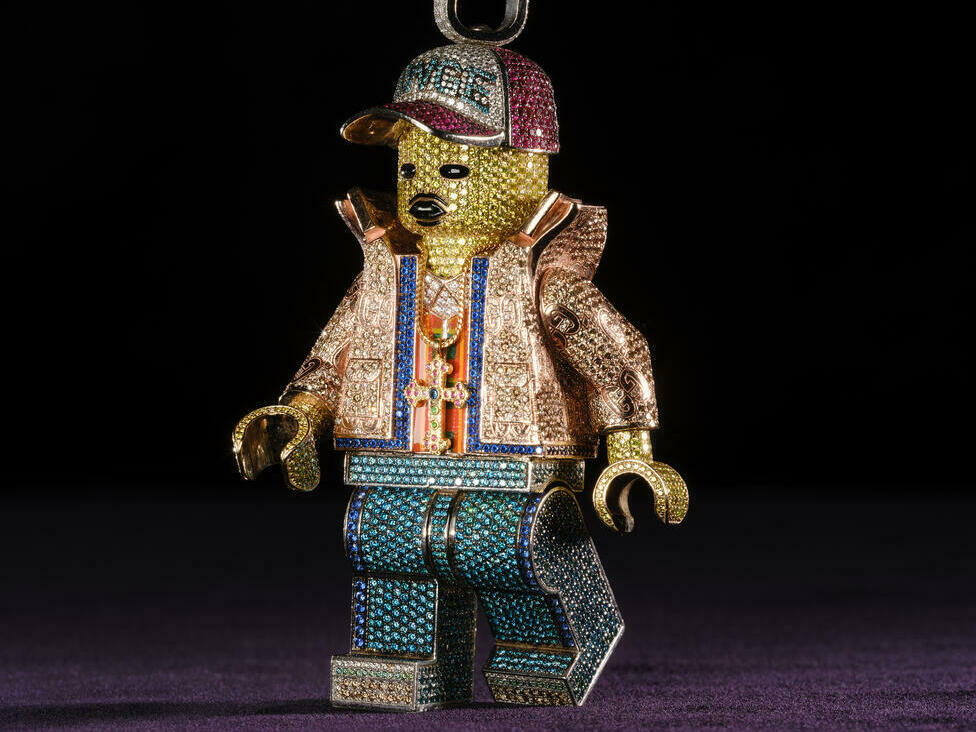[ad_1]

Slick Rick is thought for his eyepatch and the crowns he typically wears.
Janette Beckman/Courtesy of Fahey/Klein Gallery
disguise caption
toggle caption
Janette Beckman/Courtesy of Fahey/Klein Gallery

Slick Rick is thought for his eyepatch and the crowns he typically wears.
Janette Beckman/Courtesy of Fahey/Klein Gallery
Taste Flav‘s clock. Nicki Minaj’s Barbie pendant. Slick Rick’s crown and eyepatch. These are well-known symbols of hip-hop. However maybe probably the most iconic piece of all of them is Ghostface Killah’s eagle cuff.
The gold bracelet weighs 5 kilos and options an eagle, wings outstretched, touchdown on the cuff. And it is on view proper now on the American Museum of Pure Historical past in New York.

Ghostface Killah sporting his iconic gold eagle cuff.
Atsuko Tanaka/American Museum of Pure Historical past
disguise caption
toggle caption
Atsuko Tanaka/American Museum of Pure Historical past

Ghostface Killah sporting his iconic gold eagle cuff.
Atsuko Tanaka/American Museum of Pure Historical past
“I used to be a extremely huge fan of Wu-Tang,” mentioned Kevin “Coach Ok” Lee, visitor curator for the present “Ice Chilly: An Exhibition of Hip-Hop Jewellery” and co-founder and chief working officer of High quality Management Information. “So I keep in mind when [Ghostface] acquired that piece and confirmed it — and to see that in particular person at the moment? It simply blew me away.”
YouTube
From chains to diamonds
However the early hip-hop artists did not begin out with big gold eagles, diamond-encrusted nameplates or Rolexes.
As an alternative, mentioned music journalist and exhibition visitor curator Vikki Tobak, they shopped at small group jewellery shops, normally owned by immigrants. “There weren’t many diamonds, simply, , a gold cap on your tooth, a easy nameplate, simply to point out success.”
From there, it went to Run-DMC’s thick gold ropes, pendants just like the NAS QB pendant, representing the Queensbridge homes, and the diamond-studded Roc-A-Fella medallion for the document label co-founded by Jay-Z; and finally onto playful gadgets like A$AP Rocky’s jewel-encrusted Lego determine, with absolutely operational legs and arms.

This playful Lego pendant, designed for A$AP Rocky by Alex Moss X Pavē in 2022, is fabricated from 14-karat gold with multicolored diamonds, sapphire, ruby, and enamel.
Alvaro Keding/© AMNH
disguise caption
toggle caption
Alvaro Keding/© AMNH

This playful Lego pendant, designed for A$AP Rocky by Alex Moss X Pavē in 2022, is fabricated from 14-karat gold with multicolored diamonds, sapphire, ruby, and enamel.
Alvaro Keding/© AMNH
“Hip-hop jewellery grew up together with the music and the tradition,” Tobak mentioned.
As hip-hop turned extra mainstream and the artists turned wealthier, the jewellery turned dearer and elaborate.
Not every bit is about wealth
With so many spectacularly shiny objects, it is likely to be straightforward to overlook a extra humble one nestled in a case: an oblong ring with the letter “R” within the middle.
It is a Juice Crew ring, loaned by Roxanne Shanté, a radio host and a pioneer of battle rap — her breakout music “Roxanne’s Revenge” was recorded when she was 14 and dwelling in Queensbridge.
YouTube
“Again within the day, an individual who had juice had respect and had management over their neighborhood and conditions,” Shanté mentioned. “So should you noticed somebody with the Juice Crew ring, then you definately knew that was an individual that you would be able to belief. You knew that was an individual you could possibly go to together with your issues. So that you needed to earn it. The Juice ring might by no means be purchased. It needed to be given to you.”
She mentioned folks earned that ring by doing issues like serving to ship a child to camp or mediating a dispute.
To her, it is a image that hip-hop is a household.

Roxanne Shanté, a member of the influential hip-hop collective Juice Crew as a teen within the Nineteen Eighties, is the one feminine rapper to have been given a Juice Crew ring, which boasts a diamond-encrusted “R.”
Alvaro Keding/© AMNH
disguise caption
toggle caption
Alvaro Keding/© AMNH

Roxanne Shanté, a member of the influential hip-hop collective Juice Crew as a teen within the Nineteen Eighties, is the one feminine rapper to have been given a Juice Crew ring, which boasts a diamond-encrusted “R.”
Alvaro Keding/© AMNH
Different items within the present have African iconography, like a leather-based pendant worn by a member of De La Soul. Curator Tobak mentioned the exhibition purposefully connects these items to different anthropology sections within the museum as a result of the story of hip-hop and jewellery is intrinsically linked to the African diaspora.
“What we select to placed on our physique is such a human factor that hip-hop has simply taken to the nth diploma. And I feel that’s the greater, like highly effective story right here,” she mentioned.

“Ice Chilly: An Exhibition of Hip-Hop Jewellery” is on the American Museum of Pure Historical past as a part of the Allison and Roberto Mignone Halls of Gems and Minerals.
Alvaro Keding/© AMNH
disguise caption
toggle caption
Alvaro Keding/© AMNH
[ad_2]




